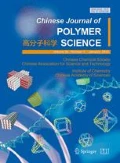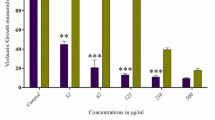Abstract
Gram-negative bacteria can cause serious infections and are well known problems in biomedical practices. Biofilms of gram-negative bacteria are notorious for their frequently encountered resistance toward antibiotics. We demonstrate that α/β chimeric polypeptide molecular brush (α/β CPMB) exerts potent activities against antibiotic-resistant gram-negative bacteria. MTT viability assay, bacterial colony counting, and live/dead staining all indicate that α/β CPMB not only inhibits biofilm formation of gram-negative Pseudomonas aeruginosa and Acinetobacter baumannii, but also effectively disrupts mature biofilms that are highly resistant to one of the most active antibiotics—colistin. The superior antibacterial performance of the α/β CPMB implies its potential topical applications in treating biofilms.
Similar content being viewed by others
References
Parsek, M. R.; Singh, P. K. Bacterial biofilms: An emerging link to disease pathogenesis. Annu. Rev. Microbiol. 2003, 57, 677–701.
Drescher, K.; Dunkeld, J.; Nadella, C. D.; Teeffelen, S. V.; Grnjaa, I.; Wingreenb, N. S.; Stone, H. A.; Bassler, B. L. Architectural transitions in Vibrio cholerae biofilms at single-cell resolution. Proc. Natl. Acad. Sci. 2016, 113, 2066–2072.
Zheng, C. X.; Zhao, Y.; Liu, Y. Recent advances in self-assembled nano-therapeutics. Chinese J. Polym. Sci. 2018, 36, 322–346.
Wei, T.; Yu, Q.; Chen, H. Responsive and synergistic antibacterial coatings: Fighting against bacteria in a smart and effective way. Adv. Healthc. Mater. 2019, 8, 1801381–1801405.
Cheung, R. C. F.; Wong, J. H.; Pan, W. L.; Chan, Y. S.; Yin, C. M.; Dan, X. L.; Wang, H. X.; Fang, E. F.; Lam, S. K.; Ngai, P. H. K.; Xia, L. X.; Liu, F.; Ye, X. Y.; Zhang, G. Q.; Liu, Q. H.; Sha, O.; Lin, P.; Ki, C.; Bekhit, A. A.; Bekhit, A. E. D.; Wan, D. C. C.; Ye, X. J.; Xia, J.; Ng, T. B. Antifungal and antiviral products of marine organisms. Appl. Microbiol. Biotechnol. 2014, 98, 3475–3494.
Kooa, H.; Allanb, R. N.; Howlind, R. P.; Hall-Stoodleye, L.; Stoodley, P. Targeting microbial biofilms: Current and prospective therapeutic strategies. Nat. Rev. Microbiol. 2017, 15, 740–755.
Kim, S. K.; Lee, J. H. Biofilm dispersion in Pseudomonas aeruginosa. J. Microbiol. 2016, 54, 71–85.
Jian, J. R.; Jie, Y. S.; Mei, T. L.; Ai, X. S.; Rong, X. Z.; Fang, L. S.; Hua, Y. J.; Quan, R. L.; Jie, Z. A biomimetic surface for infection-resistance through assembly of metal-phenolic networks. Chinese J. Polym. Sci. 2018, 36, 576–583.
Vögeling, H.; Pinnapireddy, S. R.; Seitz, B.; Bakowsky, U. Indocyanine green loaded PLGA film coated coronary stents for photo-triggered in situ biofilm eradication. Colloid Interface Sci. Commun. 2018, 27, 35–39.
Reffuveille, F.; Fuente-Núñez, C. D. L.; Mansour, S.; Hancock, R. E. W. A broad-spectrum antibiofilm peptide enhances antibiotic action against bacterial biofilms. Antimicrob. Agents Chemother. 2014, 58, 5363–5371.
Uppu, D. S. S. M.; Konai, M. M.; Sarkar, P.; Samaddar, S.; Fensterseifer, I. C. M.; Farias-Junior, C.; Krishnamoorthy, P.; Shome, B. R.; Franco, O. V. L.; Haldar, J. Membrane-active macromolecules kill antibiotic-tolerant bacteria and potentiate antibiotics towards gram-negative bacteria. PLoS One 2017, 12, 1–30.
Li, X. H.; Lee, J. H. Antibiofilm agents: A new perspective for antimicrobial strategy. J. Microbiol. 2017, 55, 753–766.
Amato, S. M.; Fazen, C. H.; Henry, T. C.; Mok, W. K.; Orman, M. A.; Sandvik, E. L.; Volzing, K. G.; Brynildsen, M. The role of metabolism in bacterial persistence. Front. Microbiol. 2014, 5, 1–9.
Balaban, N. Q.; Gerdes, K.; Lewis, K.; McKinney, J. D. A problem of persistence: Still more questions than answers? Nat. Rev. Microbiol. 2013, 11, 587–591.
Kumagai, Y.; Matsuo, J.; Cheng, Z.; Yoshihiro; Hayakawa; Rikihisa, Y. Cyclic dimeric GMP signaling regulates intracellular aggregation, sessility, and growth of Ehrlichia chaffeensis. Infect. Immun. 2011, 79, 3905–3912.
Lewis, K. Persister cells. Annu. Rev. Microbiol. 2010, 64, 357–372.
Balaban, N. Q.; Merrin, J.; Chait, R.; Kowalik, L.; Leibler, S. Bacterial persistence as a phenotypic switch. Science 2004, 305, 1622–1626.
Jie, Z. Y.; Sheng, H. S.; Zhong, D. J. ε-Poly(L-lysine)-based hydrogels with fast-acting and prolonged antibacterial activities. Chinese J. Polym. Sci. 2018, 36, 1239–1250.
Chua, S. L.; Yam, J. K. H.; Hao, P.; Adav, S. S.; Salido, M. M.; Liu, Y.; Givskov, M.; Sze, S. K.; Tolker-Nielsen, T.; Yang, L. Selective labelling and eradication of antibiotic-tolerant bacterial populations in Pseudomonas aeruginosa biofilms. Nat. Commun. 2016, 7, 10750–10760.
Yang, Q.; Li, M.; Spiller, O. B.; Andrey, D. O.; Hinchliffe, P.; Li, H.; MacLean, C.; Niumsup, P.; Powell, L.; Pritchard, M.; Papkou, A.; Shen, Y.; Portal, E.; Sands, K.; Spencer, J.; Tansawai, U.; Thomas, D.; Wang, S.; Wang, Y.; Shen, J.; Walsh, T. Balancing mcr-1 expression and bacterial survival is a delicate equilibrium between essential cellular defence mechanisms. Nat. Commun. 2017, 8, 2054–2066.
Zhao, D.; Xu, X. D.; Yuan, S. S.; Yan, S. J.; Wang, X. H.; Luan, S. F.; Yin, J. H. Fouling-resistant behavior of liquid-infused porous slippery surfaces. Chinese J. Polym. Sci. 2017, 35, 887–896.
Wu, J.; Zhang, C.; Xu, S.; Pang, X.; Cai, G.; Wang, J. Preparation of zwitterionic polymer-functionalized cotton fabrics and the performance of anti-biofouling and long-term biofilm resistance. Colloid Interface Sci. Commun. 2018, 24, 98–104.
Hancock, R. E. W.; Sahl, H. G. Antimicrobial and host-defense peptides as new anti-infective therapeutic strategies. Nat. Biotechnol. 2006, 24, 1551–1557.
Nijnik, A.; Hancock, R. E. W. Host defence peptides: Antimicrobial and immunomodulatory activity and potential applications for tackling antibiotic-resistant infections. Emerg. Health Threats J. 2009, 2, 1–7.
Yang, Y.; Cai, Z.; Huang, Z.; Tang, X.; Zhang, X. Antimicrobial cationic polymers: From structural design to functional control. Polym. J. 2017, 50, 33–44.
Brogden, K. A. Antimicrobial peptides: Pore formers or metabolic inhibitors in bacteria? Nat. Rev. Microbiol. 2005, 3, 238–250.
Liu, S. P.; Zhou, L.; Lakshminarayanan, R.; Beuerman, R. W. Multivalent antimicrobial peptides as therapeutics: Design principles and structural diversities. Int. J. Pept. Res. Ther. 2010, 16, 199–213.
Lam, S. J.; Wong, E. H. H.; O’Brien-Simpson, N. M.; Pantarat, N.; Blencowe, A.; Reynolds, E. C.; Qiao, G. G. Bionano interaction study on antimicrobial star-shaped peptide polymer nanoparticles. ACS Appl. Mater. Interfaces 2016, 8, 33446–33456.
Cuthbert, T. J.; Hisey, B.; Harrison, T. D.; Trant, J. F.; Gillies, E. R.; Ragogna, P. J. Surprising antibacterial activity and selectivity of hydrophilic polyphosphoniums featuring sugar and hydroxy substituents. Angew. Chem. Int. Ed. 2018, 57, 12707–12710.
Li, P.; Zhou, C.; Rayatpisheh, S.; Ye, K.; Poon, Y. F.; Hammond, P. T.; Duan, H.; Chan-Park, M. B. Cationic peptidopolysaccharides show excellent broad-spectrum antimicrobial activities and high selectivity. Adv. Mater. 2012, 24, 4130–4137.
Ong, Z. Y.; Wiradharma, N.; Yang, Y. Y. Strategies employed in the design and optimization of synthetic antimicrobial peptide amphiphiles with enhanced therapeutic potentials. Adv. Drug Delivery Rev. 2014, 78, 28–45.
Sang, P.; Shi, Y.; Teng, P.; Cao, A.; Xu, H.; Li, Q.; Cai, J. Antimicrobial AApeptides. Curr. Top. Med. Chem. 2017, 17, 1266–1279.
Mowery, B. P.; Lee, S. E.; Kissounko, D. A.; Epand, R. F.; Epand, R. M.; Weisblum, B.; Stahl, S. S.; Gellman, S. H. Mimicry of antimicrobial host-defense peptides by random copolymers. J. Am. Chem. Soc. 2007, 129, 15474–15476.
Yang, L. H.; Gordon, V. D.; Mishra, A.; Som, A.; Purdy K. R.; Davis, M. A.; Tew, G. N.; Gerard C. L. W. Synthetic antimicrobial oligomers induce a composition-dependent topological transition in membranes. J. Am. Chem. Soc. 2007, 129, 12141–12147.
Lienkamp, K.; Madkour, A. E.; Musante, A.; Nelson, C. F.; Sslein, K. N.; Tew, G. N. Antimicrobial polymers prepared by ROMP with unprecedented selectivity: A molecular construction kit approach. J. Am. Chem. Soc. 2008, 130, 9836–9843.
Tew, G. N.; Scott, R. W.; Klein, M. L.; Degrado, W. F. De novo design of antimicrobial polymers, foldamers, and small molecules: From discovery to practical applications. Acc. Chem. Res. 2010, 43, 30–39.
Liu, R.; Chen, X.; Falk, S. P.; Mowery, B. P.; Karlsson, A. J.; Weisblum, B.; Palecek, S. P.; Masters, K. S.; Gellman, S. H. Structure-activity relationships among antifungal Nylon-3 polymers: Identification of materials active against drug-resistant strains of Candida albicans. J. Am. Chem. Soc. 2014, 136, 4333–4342.
Qian, Y.; Qi, F.; Chen, Q.; Zhang, Q.; Qiao, Z.; Zhang, S.; Wei, T.; Yu, Q.; Yu, S.; Mao, Z.; Gao, C.; Ding, Y.; Cheng, Y.; Jin, C.; Xie, H.; Liu, R. Surface modified with a host defense peptide-mimicking β-peptide polymer kills bacteria on contact with high efficacy. ACS Appl. Mater. Interfaces 2018, 10, 15395–15400.
Zhang, D.; Qian, Y.; Zhang, S.; Ma, P.; Zhang, Q.; Shao, N.; Qi, F.; Xie, J.; Dai, C.; Zhou, R.; Qiao, Z.; Zhang, W.; Sheng, C.; Runhui, L. α-β Chimeric polypeptide molecular brushes display potent activity against superbugs-methicillin resistant Staphylococcus aureus. Sci. China Mater. 2018, 21, 1–7.
Verduzco, R.; Li, X.; Peseka, S. L.; Stein, G. E. Structure, function, self-assembly, and applications of bottlebrush copolymers. Chem. Soc. Rev. 2015, 44, 2405–2420.
Zhang, M.; Müller, A. H. E. Cylindrical polymer brushes. J. Polym. Sci., Part A: Polym. Chem. 2005, 43, 3461–3481.
Sheiko, S. S.; Sumerlin, B. S.; Matyjaszewski, K. Cylindrical molecular brushes: Synthesis, characterization, and properties. Prog. Polym. Sci. 2008, 33, 759–785.
Lu, X.; Tran, T. H.; Jia, F.; Tan, X.; Davis, S.; Krishnan, S.; Amiji, M. M.; Zhang, K. Providing oligonucleotides with steric selectivity by brush-polymer-assisted compaction. J. Am. Chem. Soc. 2015, 137, 12466–12469.
Wang, J.; Lu, H.; Ren, Y.; Zhang, Y.; Morton, M.; Cheng, J.; Lin, Y. Interrupted helical structure of grafted polypeptides in brush-like macromolecules. Macromolecules 2011, 44, 8699–8708.
Zhang, Y.; Yin, Q.; Lu, H.; Xia, H.; Lin, Y.; Cheng, J. PEG-polypeptide dual brush block copolymers: Synthesis and application in nanoparticle surface PEGylation. ACS Macro Lett. 2013, 2, 809–813.
Li, Z. Synthesis of hetero-grafted amphiphilic diblock molecular brushes and their self-assembly in aqueous medium. Macromolecules 2010, 43, 1182–1184.
Fan, J.; Borguet, Y. P.; Su, L.; Nguyen, T. P.; Wang, H.; He, X.; Zou, J.; Woole, K. L. Two-dimensional controlled syntheses of polypeptide molecular brushes via N-carboxyanhydride ring-opening polymerization and ring-opening metathesis polymerization. ACS Macro Lett. 2017, 6, 1031–1035.
Gao, Q.; Yu, M.; Su, Y. J.; Xie, M. H.; Zhao, X.; Li, P.; Ma, P. X. Rationally designed dual functional block copolymers for bottlebrush-like coatings: In vitro and in vivo antimicrobial, antibiofilm, and antifouling properties. Acta Biomater. 2017, 51, 112–124.
Elshaarawya, R. F. M.; Refaeec, A. A.; El-Sawi, E. A. Pharmacological performance of novel poly-(ionic liquid)-grafted chitosan-N-salicylidene Schiff bases and their complexes. Carbohydr. Polym. 2016, 146, 376–387.
Rahman, M. A.; Bam, M.; Luat, E.; Jui, M. S.; Ganewatta, M. S.; Shokfai, T.; Nagarkatti, M.; Decho, A. W.; Tang, C. Macromolecular-clustered facial amphiphilic antimicrobials. Nat. Commun. 2018, 9, 5231–5240.
Vincek, M. K.; Mor, A.; Gorgieva, S.; Kokol, V. Antibacterial activity and cytotoxycity of gelatine-conjugated lysine-based peptides. J. Biomed. Mater. Res., Part A 2017, 105, 3110–3126.
Yao, D.; Guo, Y.; Chen, S.; Tang, J.; Chen, Y. Shaped core/shell polymer nanoobjects with high antibacterial activities via block copolymer microphase separation. Polymer 2013, 54, 3485–3491.
Yang, C.; Ding, X.; Ono, R. J.; Lee, H.; Hsu, L. Y.; Tong, Y. W.; Hedrick, J.; Yang, Y. Y. Brush-like polycarbonates containing dopamine, cations, and PEG providing a broad-spectrum, antibacterial, and antifouling surface via one-step coating. Adv. Mater. 2014, 26, 7346–7351.
Mohamed, M. F.; Brezden, A.; Mohammad, H.; Chmielewski, J.; Seleem, M. N. A short D-enantiomeric antimicrobial peptide with potent immunomodulatory and antibiofilm activity against multidrug-resistant Pseudomonas aeruginosa and Acinetobacter baumannii. Sci. Rep. 2017, 7, 6953.
Acknowledgments
This work was financially supported by the National Natural Science Foundation of China (Nos. 21574038, 21774031, and 21861162010), the Natural Science Foundation of Shanghai (No. 18ZR1410300), the “Eastern Scholar Professorship” from Shanghai local government (No. TP2014034), the national special fund for State Key Laboratory of Bioreactor Engineering (No. 2060204), and the Fundamental Research Funds for the Central Universities (No. 22221818014).
Author information
Authors and Affiliations
Corresponding author
Rights and permissions
About this article
Cite this article
Zhang, S., Xiao, XM., Qi, F. et al. Biofilm Disruption Utilizing α/β Chimeric Polypeptide Molecular Brushes. Chin J Polym Sci 37, 1105–1112 (2019). https://doi.org/10.1007/s10118-019-2278-0
Received:
Accepted:
Published:
Issue Date:
DOI: https://doi.org/10.1007/s10118-019-2278-0




